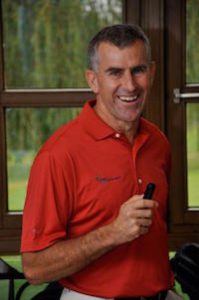We’ve all heard a lot of tips and tricks about putting, but what actually makes a good putter good. Today we talk with leading biomechanist Dr Rob Neal as he shares his research and experience working with the best players and putting coaches in the world.
The key to being a successful putter is to deliver the putter head with the right energy at impact and the club face pointing in the right direction and do that consistently well.
You cannot on one stroke be perfect and on the next, nowhere near the mark. What you will see with expertise in putting is really high levels of consistency with putter head delivery.
If you measure them on a SAM or a GBD system you will find that the standard deviations of face angles, dynamic loft, etc are approximately 0.3 of a degree. That is very low and that might be over 10 or 15 putting strokes. The levels of variability or the standard deviations as you move proximally at expert players, increases a little bit and this is their mechanism of coordinating the stroke.
Good putters are also able to coordinate their movement and compensate if need be.
Good putters are also able to coordinate their movement and compensate if need be. If they pull a little bit too hard with the lead arm they can compensate by doing something different with the forearm and the hand in order to deliver the club or the putter, with the precision necessary to make the putt. If you didn’t have this subtle coordination amongst the body segments involved in a stroke, then if one part of the body made an error on the stroke, then that would be it. It will be all over.
All of the putting coaches that Dr Rob Neal works with (David Orr, Paul Hurrion and Phil Kenyon) strongly argue that this coordination of the body segments is one of the things that separate the good putter from the really good putters.
Really good putters have the ability to compensate or modify what they are doing within the stroke in order to produce the right outcome in the putter head.
The process that I would typically go through is examine what someone does with the putter first. What the stroke mechanics look like,face angle, dynamic loft, putter path, rise angle, etc and then work my way from the putter back to what the body was doing in order to produce that particular pattern of movement.
The process that I would typically go through is examine what someone does with the putter first.
The challenge then is to find good elements in anyone’s putting stroke and then be able to modify those things and maybe disruptive in their technique and really make a difference for them putting reasonably well, and putting poorly.
There is no one solution that we would dictate is right for everyone because it’s to change a motor pattern, so we are looking for things that have the maximum impact with the minimum change.
Sometimes, that might be changing the putter or changing the loft and lie on the putter. If the stroke itself is really consistent but there is too much dynamic loft, at impact then the simple solution would be to change the loft on the putter, reduce it by a couple of degrees or if there is not enough dynamic loft at impact, then maybe the ball needs to be put further forward in the stance so that you could make the same stroke but catch it at a different point during the arc that the putter is making.
I can tell you as opposed to what some people think, “try to keep the hands out of your putting stroke”, every person we have measured has hand action during their stroke. So it’s not like you can get rid of it, in fact, it’s probably a good thing to have in there.
[aesop_chapter title=”About our guest” bgtype=”img” full=”on” img=”http://golfsciencelab.com/wp-content/uploads/2016/02/putter.jpg” bgcolor=”#888888″ revealfx=”off”]
Dr Rob Neal
 Dr Robert Neal, CEO, established golf biodynamics (GBD) in 2000 with the intention of providing the best possible biomechanics service available to golfers and teaching professionals alike. A unique skill set has made this a reality.
Dr Robert Neal, CEO, established golf biodynamics (GBD) in 2000 with the intention of providing the best possible biomechanics service available to golfers and teaching professionals alike. A unique skill set has made this a reality.
Today, the GBD philosophy towards performance enhancement has not changed, we are proponents of an integrated approach to supporting “the golf athlete”. That is, we combine a scientific approach with the practical skills necessary to bring about technical change, all of which is performed in conjunction with the teaching professional and athlete’s own support network (which may include the athletic development specialist, physical therapist, podiatrist, nutritionist etc).
The diverse nature of our clientele reflects the extensive skill set that rob and others in our GBD team bring to the table. While GBD regularly works with golfers of all playing abilities (playing professionals and recreational golfers) we also consult to teaching professionals and organizations such as the Jim McLean golf schools, the Titleist Performances Institute (TPI), the Australian Institute of Sport (AIS), various PGA’s worldwide (Australia, New Zealand, US, UK, Denmark, Germany, Sweden, and Switzerland), The Danish Golf Union, The German National Team and more.
Links / Resources
This Episode’s Sponsor
 K-VEST is the industry’s only human motion learning system. The all-in-one wireless system that instantaneously measures players’ power signatures and 3D data. The system that assesses player characteristics and generates insightful reports. The system that automatically flows those reports into a powerful coaching and training program builder.
K-VEST is the industry’s only human motion learning system. The all-in-one wireless system that instantaneously measures players’ power signatures and 3D data. The system that assesses player characteristics and generates insightful reports. The system that automatically flows those reports into a powerful coaching and training program builder.
But that’s just the beginning. K-VEST doesn’t only provide you with an extensive library of pre-built training programs and drills, but also with the tools to customize them. And these pre-loaded resources always put real-time auditory and visual feedback front and center—making it possible for clients to feel new movement patterns. Supporting this state-of-the-art wearable technology are turnkey marketing programs that empower professionals to grow their businesses. In fact, it’s everything today’s pro needs to achieve greater success… a human motion learning system.
Music Includes
Only Instrumental by Broke for Free
Let’s start at the beginning by Lee Rosevere
Simple Hop by Broke for Free
Something Elated by Broke for Free
Drop of Water in the Ocean by Broke for Free



